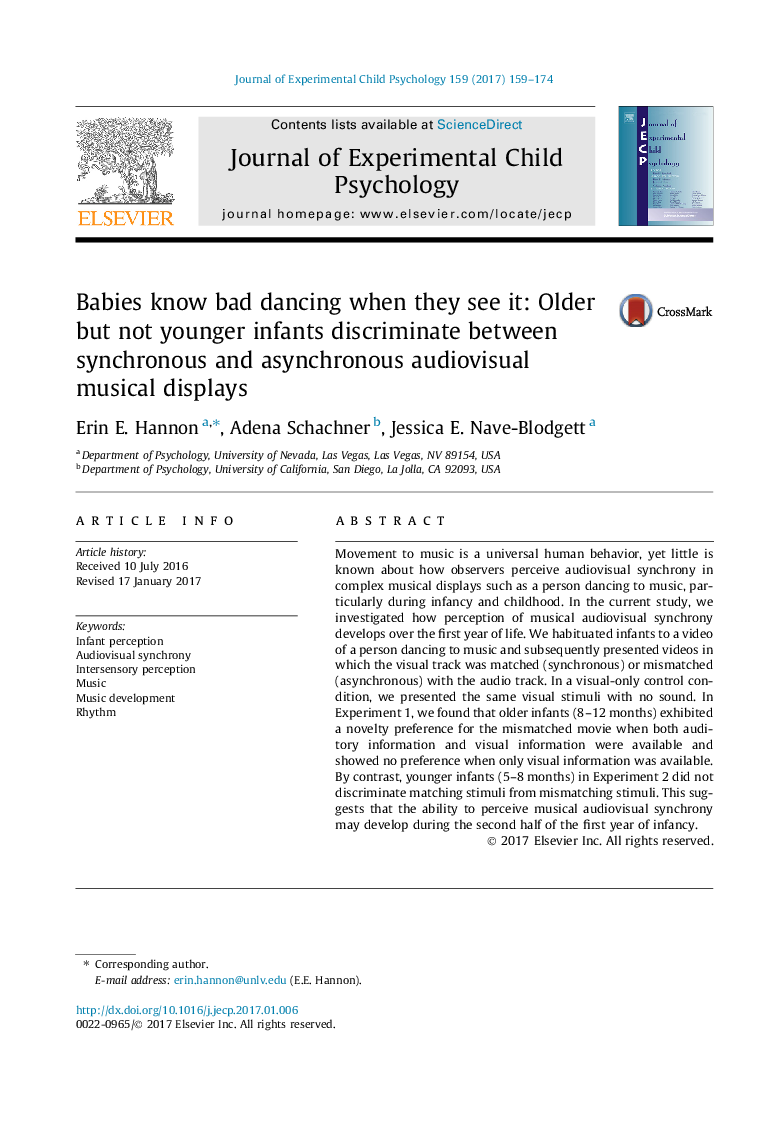| کد مقاله | کد نشریه | سال انتشار | مقاله انگلیسی | نسخه تمام متن |
|---|---|---|---|---|
| 5039986 | 1473453 | 2017 | 16 صفحه PDF | دانلود رایگان |
عنوان انگلیسی مقاله ISI
Babies know bad dancing when they see it: Older but not younger infants discriminate between synchronous and asynchronous audiovisual musical displays
ترجمه فارسی عنوان
نوزادان هنگامی که آن را می بینند رقص بدی را می دانند: نوزادان قدیمی تر اما نه جوانتر بین نمایش های صوتی و تصویری صوتی همزمان و غیر همزمان
دانلود مقاله + سفارش ترجمه
دانلود مقاله ISI انگلیسی
رایگان برای ایرانیان
کلمات کلیدی
ادراک نوزادان، هماهنگی صوتی و تصویری، ادراک درونی، موسیقی توسعه موسیقی، ریتم،
موضوعات مرتبط
علوم انسانی و اجتماعی
روانشناسی
روانشناسی رشد و آموزشی
چکیده انگلیسی
Movement to music is a universal human behavior, yet little is known about how observers perceive audiovisual synchrony in complex musical displays such as a person dancing to music, particularly during infancy and childhood. In the current study, we investigated how perception of musical audiovisual synchrony develops over the first year of life. We habituated infants to a video of a person dancing to music and subsequently presented videos in which the visual track was matched (synchronous) or mismatched (asynchronous) with the audio track. In a visual-only control condition, we presented the same visual stimuli with no sound. In Experiment 1, we found that older infants (8-12Â months) exhibited a novelty preference for the mismatched movie when both auditory information and visual information were available and showed no preference when only visual information was available. By contrast, younger infants (5-8Â months) in Experiment 2 did not discriminate matching stimuli from mismatching stimuli. This suggests that the ability to perceive musical audiovisual synchrony may develop during the second half of the first year of infancy.
ناشر
Database: Elsevier - ScienceDirect (ساینس دایرکت)
Journal: Journal of Experimental Child Psychology - Volume 159, July 2017, Pages 159-174
Journal: Journal of Experimental Child Psychology - Volume 159, July 2017, Pages 159-174
نویسندگان
Erin E. Hannon, Adena Schachner, Jessica E. Nave-Blodgett,
